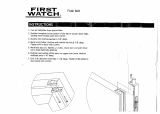
D) Make sure that the cross bore hole will be completely covered
by the outside escutcheon and that the Nostalgic logo is
oriented correctly.
“Inside” Half
E) Locate the interior cylinder assembly (Part #6). This can
easily be identifi ed because it has two holes drilled through
the face of the cylinder, see Figure #5. Assemble the interior
cylinder assembly and escutcheon as outlined in Step 5B.
F) Rotate the interior cylinder bar so that it is oriented in the
opposite orientation that you used in Step 5C. Holding the
exterior half of the deadbolt on the door, install the interior
half of the deadbolt. The driver bars will mate together in
the hub of the deadbolt latch. Depending on the thickness of
your door, the interior and exterior should be able to sit fl ush
against the door. If they do, go to Step 5H.
G) Adjustments must be made for thinner doors where the
deadbolt cannot sit fl ush against the door. Remove the interior
half of the deadbolt and set it aside. Holding the exterior half
in place, observe how much of the cylinder driver bar (Part
#4A) sticks through the latch, see Figure #7A & #7B. The
tangs on the driver bar are scored with marks to make this
easier. Count the marks showing through on a single tang and
if desired, mark the tang using a marker. Remove the exterior
half of the deadbolt. Using wire cutters, carefully snip off the
tangs at the last mark that was visible when it was installed
through the latch, being careful not to bend the tangs.
Reinstall the exterior half of the deadbolt to verify that the
tangs have been cut to the length which only leaves a small
amount still protruding from the latch. Follow these same
steps for the inside cylinder assembly.
H) Locate the two 2-3/4” machine screws (Part #7). While
holding both the interior and exterior halves in place, insert
the machine screws through the interior cylinder assembly.
The screws will go through the latch and into the back
of the exterior cylinder assembly. Slowly screw in the
machine screws until nearly snug. Align the escutcheons for
appearance and fully tighten the screws.
I) Insert, turn, and remove the key in each side to make sure that
the deadbolt operates smoothly. If not, loosen the screws and
realign the escutcheons. With the screws not fully tightened,
turn the key on each side of the door to determine if both
sides operate smoothly. If only one side operates smoothly,
it is likely that the cylinder assembly driver bar tangs are too
long coming from the other side and are rubbing on the back
of the cylinder assembly. Using the wire cutters, trim them
back slightly and see if this fi xes the issue. If not, call or
customer service department at 800-522-7336 for assistance.
J) Once you have tested the action of the deadbolt and it is
acceptable, move on to Step 6.
Step 6
Installing the Door Reinforcer and Strike
Note: If door jamb is already drilled, go to Step 6E below.
A) With the deadbolt in the unlocked position, close the door.
From the inside of the house, turn the key and identify where
the bolt is contacting the door jamb. Lightly mark this with
a pencil on the door jamb. Measuring in from the door stop
trim, identify the center mark where the bolt hole needs to
be drilled. Hint: If you cannot see the bolt clearly, or cannot
mark the jamb with a pencil because the door is closed, you
can cover the end of the bolt with a light amount of lipstick or
similarly visible material. When you turn the key, the lipstick
will mark the door jamb.
B) Using a 7/8” drill bit, drill two holes centered 5/16” above
and below the center mark. These holes will overlap. Make
sure each one is at least 1-1/8” deep.
C) Clean out the hole (if needed) and insert the black dust box
(Part #10). Close the door carefully, making sure not to crush
the dust box. Make sure that the deadbolt and dust box line
up. If not, carefully enlarge the hole as needed.
D) Using the strike plate (Part #13), mark the area to be mortised
out for the dust box (Part #10), door frame reinforcer (Part
#11), and strike plate. Use a chisel to mortise this area and
make sure that once assembled, the strike plate sits fl ush to
the door jamb.
E) Place the door frame reinforcer over the dust box. Using the
Page 3 - PK165
Figure #7A
Figure #7B
Inside of Door
Deadbolt extends right
Inside of Door
Deadbolt extends left
$OOR&RAME
2EINFORCER
0ART
3TRIKE0LATE
0ART
v7OOD3CREWS
0ART
v,ATCH3TRIKE
7OOD3CREWS
0ART
$OOR
3TOP
4RIM
$UST"OX
0ART
Figure #9










